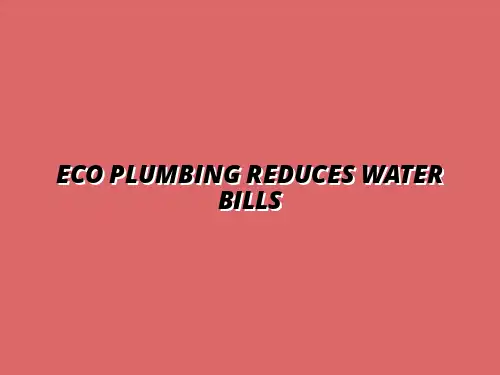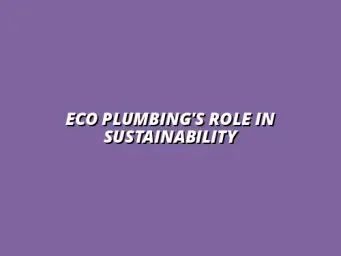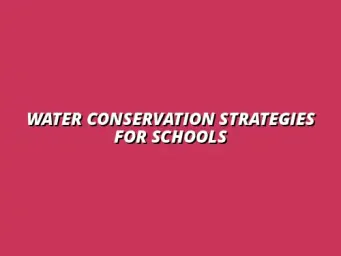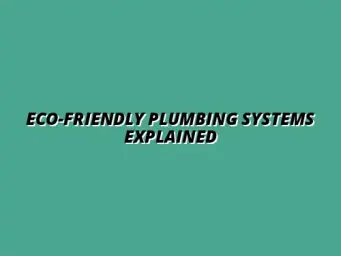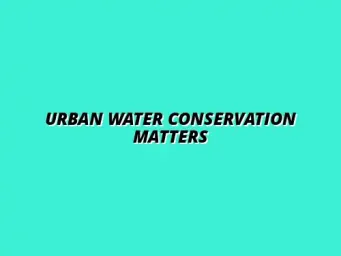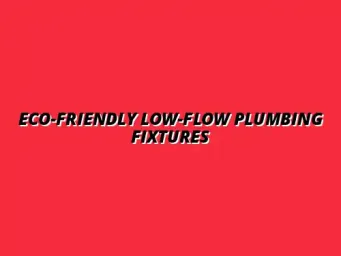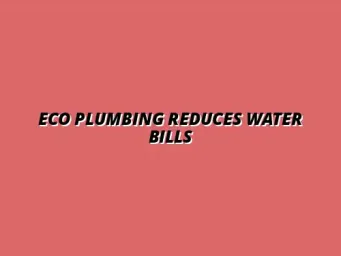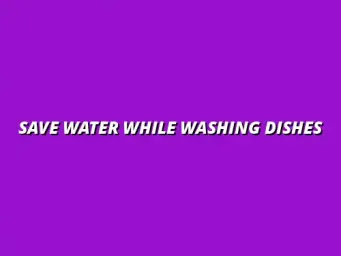Understanding Eco Plumbing and Its Benefits
Eco plumbing is an innovative approach focused on creating green plumbing solutions that promote **sustainable water use**. This type of plumbing not only conserves water but also helps reduce energy consumption, making it a win-win for the environment and your wallet! By embracing eco plumbing, households can significantly lower their water bills while also contributing to a healthier planet. Learn more about the benefits of eco-friendly plumbing for homeowners.
The benefits of eco plumbing extend beyond simple cost savings. Utilizing eco friendly systems can enhance the overall **comfort and efficiency** of your home. Additionally, it promotes a better quality of life as it encourages the use of resources that are sustainable and environmentally friendly.
Defining Eco Plumbing: A Sustainable Approach to Water Conservation
At its core, eco plumbing is about using advanced strategies and technologies to **conserve water** and energy. This involves a set of principles designed to ensure that plumbing systems operate efficiently without wasting resources. Eco plumbing practices include the use of low-flow fixtures, rainwater harvesting, and greywater recycling.
These methods not only help in reducing water consumption but also promote the idea of **sustainability** in everyday life. By adopting eco plumbing, we take a step towards a more sustainable future, aligning our household practices with the principles of responsible water use. Discover practical water-saving tips for homeowners to further reduce your water footprint.
The Principles of Eco Plumbing in Modern Practices
Eco plumbing integrates several key principles that support water conservation. Here are a few of them:
- Resource Efficiency: Using fixtures and systems that minimize waste.
- Water Recycling: Implementing systems that allow for the reuse of water.
- Energy Conservation: Reducing the energy needed to heat and move water.
These principles guide eco plumbing practices and are essential for achieving **long-term sustainability** in water management. They encourage homeowners to think critically about their consumption and the technologies they use.
How Eco Plumbing Differs from Traditional Plumbing Systems
While traditional plumbing systems focus primarily on delivering water efficiently, eco plumbing takes a broader view by emphasizing sustainability. Traditional systems often overlook the importance of **waste reduction**, while eco plumbing actively seeks to reduce water use through innovative technologies.
Additionally, eco plumbing systems typically incorporate **smart technologies** that monitor water usage and detect leaks, which traditional systems may lack. This proactive approach enables homeowners to make informed decisions about their water consumption, ultimately leading to significant savings and environmental benefits. Regular plumbing inspections can help prevent costly leaks; find out more about regular inspections to prevent plumbing leaks.
The Impact of Water Usage on Household Bills
Water usage has a direct effect on household bills, and understanding this relationship is crucial for any homeowner. With rising water costs, being mindful of consumption can lead to substantial savings over time. Households that adopt eco plumbing can often see a decrease in their monthly expenses due to efficient water use.
By analyzing how much water is actually being consumed, homeowners can identify areas in which they can improve. **Every drop counts**, especially when it comes to keeping bills manageable and ensuring resources are used wisely! Learn how eco plumbing saves money over time.
Analyzing Water Consumption Trends in Residential Areas
Water consumption trends can vary widely based on several factors, including location, season, and household size. Here are some common trends:
- Increased water use during summer months for irrigation.
- Higher consumption in larger households with more residents.
- Growing awareness and adoption of water-saving technologies.
By keeping track of these trends, homeowners can adapt their plumbing solutions to better fit their specific needs, leading to **greater efficiency** and lower bills. Regular maintenance is key to preventing issues that can drastically increase your water usage, such as frozen water heaters. Check out tips to prevent water heater freezing this winter.
The Financial Burden of Excessive Water Bills
High water bills can be a significant financial strain on many families. Understanding the reasons behind excessive charges is important to address the problem effectively. Common causes of high water bills include:
- Leaky fixtures or pipes.
- Overwatering landscaping or gardens.
- Increased usage due to lifestyle changes.
Identifying and tackling these issues not only helps reduce costs but also promotes a culture of **conservation** within the household. Taking action now can lead to a more comfortable financial future! Regular bathroom plumbing inspections can help identify potential problems before they escalate. Read more on regular bathroom plumbing inspections.
How Eco Plumbing Solutions Work to Reduce Water Consumption
Eco plumbing solutions are designed specifically to reduce water consumption without sacrificing comfort or convenience. By investing in these solutions, you can enjoy the benefits of lower bills while doing your part for the environment. Here are some popular eco plumbing solutions:
- Low-flow fixtures, which use less water without compromising performance.
- Rainwater harvesting systems, collecting and reusing rainwater for irrigation.
- Greywater recycling systems, repurposing water from sinks and showers.
Implementing these solutions can make a significant difference in your overall water usage, leading to both financial savings and positive environmental impact!
Water-Efficient Fixtures and Their Role in Cost Savings
Water-efficient fixtures are key components of eco plumbing systems. These fixtures, such as low-flow showerheads and faucets, are designed to reduce water flow while maintaining functionality. Benefits of water-efficient fixtures include:
- Decreased water consumption, which leads to lower bills.
- Reduced energy costs associated with heating water.
- Less strain on local water supply, helping the environment.
By upgrading to these fixtures, homeowners can achieve substantial savings without compromising their daily routines. For professional plumbing services in Alcester, Birmingham, contact a local plumber.
Rainwater Harvesting Systems and Greywater Recycling Explained
Rainwater harvesting is an effective way to collect and use rainwater for non-potable purposes, such as irrigation and toilet flushing. Greywater recycling involves reclaiming water from sinks, showers, and washing machines for reuse. Here’s how these systems work:
- Rainwater Harvesting: Collects rainwater from roofs and directs it to storage tanks.
- Greywater Recycling: Filters and reuses water from household activities.
Both systems significantly reduce the demand for municipal water, leading to **lower utility bills** and reduced environmental impact. These practices not only save money but also promote responsible water use in our communities!
Addressing Common Questions About Eco Plumbing and Water Bills
When considering the adoption of eco plumbing, many homeowners often have questions regarding the initial investments required. Understanding these costs is essential for making informed decisions about sustainable upgrades. In this section, we will explore what to expect in terms of financial commitments and the potential returns on these eco-friendly investments.
Investing in eco plumbing can sometimes seem daunting, but many options are available that fit different budgets. The initial costs can vary depending on the type of eco plumbing solutions you choose to implement. However, it's crucial to view these costs not just as expenses, but as long-term investments that can lead to significant savings.
What Initial Investments Are Required for Eco Plumbing?
To grasp the overall financial picture, let's break down the common initial investments in eco plumbing:
- Low-flow fixtures: These include faucets, showerheads, and toilets designed to use less water.
- Rainwater harvesting systems: Collecting rainwater for irrigation and other non-potable uses.
- Greywater recycling systems: Reusing water from sinks and showers for irrigation.
- Smart irrigation systems: Automated systems that optimize water usage based on weather conditions.
It's essential to conduct a cost-benefit analysis before investing. Understanding the potential savings over time can help justify the upfront costs associated with eco plumbing installations.
Cost-Benefit Analysis of Eco Plumbing Installations
A thorough cost-benefit analysis can provide clarity on the financial impacts of your eco plumbing choices. Here are some factors to consider:
- **Upfront Costs:** The installation costs of eco plumbing fixtures and systems.
- **Water Savings:** The reduction in water bills due to increased efficiency.
- **Maintenance Costs:** Any ongoing costs associated with the maintenance of new systems.
- **Incentives:** Potential rebates or tax credits for adopting eco-friendly practices.
By weighing these factors, you can make informed decisions that align your financial goals with your commitment to sustainability!
Available Incentives and Rebates for Eco-Friendly Upgrades
Many homeowners may not realize that various incentives exist to support eco plumbing upgrades. Here’s a quick overview of what you might find:
- Local Utility Rebates: Many utility companies offer discounts for purchasing water-efficient appliances.
- Government Grants: Some local and federal programs provide grants to encourage sustainable practices.
- Tax Credits: You may qualify for tax deductions after making eco-friendly home improvements.
- Low-Interest Loans: Some organizations offer financing to help offset the costs of eco plumbing installations.
By exploring these incentives, you can lessen the financial burden of transitioning to eco plumbing.
Can Eco Plumbing Solutions Be Integrated into Existing Homes?
Many people wonder if they can incorporate eco plumbing solutions into their current homes without extensive renovations. The good news is that retrofitting traditional plumbing systems is quite feasible! There are multiple ways to integrate these sustainable options into your existing setup.
Adopting eco plumbing not only lessens water consumption but also adds value to your home. The transition can often be done gradually, allowing you to make changes as your budget allows.
Feasibility of Retrofitting Traditional Plumbing Systems
Retrofitting your plumbing system is more accessible than you might think! Here are some eco plumbing solutions that can be easily integrated into your existing home:
- Replacing fixtures: Swapping out old faucets and showerheads for low-flow models.
- Adding rain barrels: Collecting rainwater for irrigation purposes.
- Installing dual-flush toilets: These toilets can help save water with minimal changes to your bathroom layout.
- Upgrading irrigation systems: Implementing smart irrigation can often be done without major alterations.
With these simple updates, integrating eco plumbing into your home becomes a practical and attainable goal!
Steps for Transitioning to Eco Plumbing Without Major Renovations
If you're interested in transitioning to eco plumbing, here are some straightforward steps to guide you:
- **Evaluate your current plumbing system:** Identify areas where water consumption can be reduced.
- **Research eco-friendly fixtures:** Look for water-efficient products that fit your budget.
- **Plan your upgrades:** Prioritize changes based on potential savings and ease of installation.
- **Consult with professionals:** If needed, seek advice from eco plumbing experts to ensure proper installation.
By following these steps, you can gradually shift towards a more sustainable plumbing system without significant disruptions.
Are There Limitations to Eco Plumbing Techniques?
While eco plumbing offers many benefits, it's crucial to recognize that there are some limitations. Understanding these potential challenges can help you make informed decisions about what systems will work best for you.
Not every home is equally suited for every type of eco plumbing solution. Factors like the age of your plumbing or local regulatory requirements can influence your options.
Understanding the Potential Challenges and Solutions
Here are some common challenges that may arise when implementing eco plumbing:
- Older plumbing systems: Outdated pipes may not be compatible with modern eco fixtures.
- Local regulations: Some areas have restrictions that can limit the types of eco plumbing you can install.
- Initial costs: Some eco upgrades may require a higher upfront investment than standard options.
- Space constraints: Not all systems can fit into smaller homes or apartments without modifications.
Being aware of these challenges can help you plan effectively and find workarounds that suit your needs.
Balancing Eco Plumbing with Aesthetic Considerations
Lastly, many homeowners are concerned about how eco plumbing solutions will affect their home's overall look. Fortunately, there are plenty of stylish and modern eco fixtures available today!
When considering aesthetic appeal, focus on the following:
- Design options: Look for fixtures that complement your existing décor.
- Color choices: Many eco-friendly items come in various colors and finishes.
- Sleek designs: Choose products that offer both functionality and style.
By prioritizing both functionality and appearance, you can successfully integrate eco plumbing into your home while maintaining its visual appeal!
Evaluating the Long-Term Financial Benefits of Eco Plumbing
As you explore the world of eco plumbing, it's essential to consider its long-term financial benefits. Not only can these sustainable practices help reduce your water bills, but they can also contribute to the overall value of your home. Let's delve into how to calculate these savings over time!
Transitioning to eco plumbing can often yield substantial rewards. By making smart choices now, you can enjoy a more sustainable and cost-effective household for years to come.

